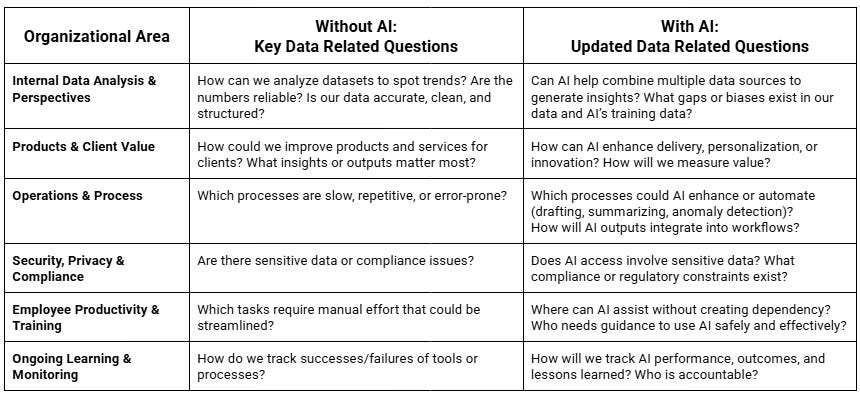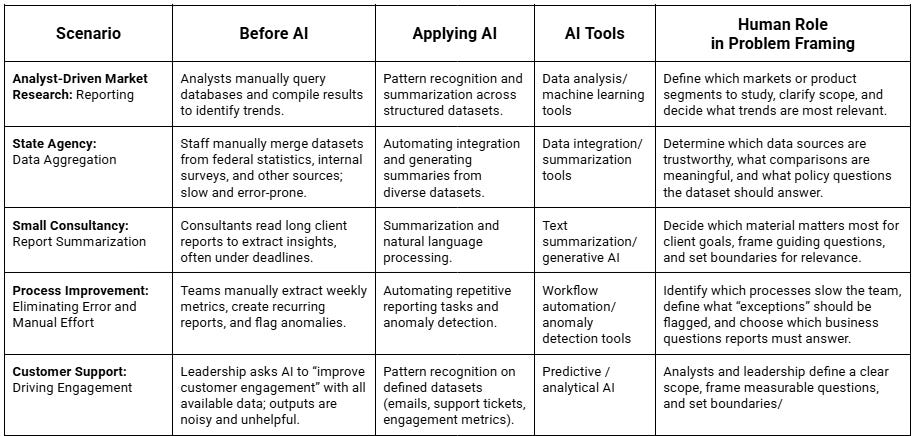AI at Work: Frame the Problem
Successfully leveraging AI tools starts with the very human task of clarifying the problem and judging whether AI is the right tool for the job.
In our last post, we put AI in context: it’s a powerful toolset developed from decades of research in logic, statistics, and computing. While today’s AI is faster and broader than many tools we use at work, it is still just a tool. Its power comes from how well it supports real work, freeing your team to focus on what requires human judgment.
Research from MIT and the RAND Corporation estimate that 60–80% of AI pilots fail, often because the problem is poorly defined. Framing the problem correctly is the first human-driven step to ensure AI tools deliver value rather than noise. A well-framed problem guides the AI application toward useful, accurate and actionable results.
In this post, we’ll explore the human skills that matter most at the Problem Framing stage. While our focus is on data-driven work, these principles apply just as well to non-data projects, too.
Your First Step: The AI Project Brief
Below is a practical checklist - your AI Project Brief - that grounds your team before jumping into implementation. Developing this short document (just a couple of pages) provides the clarity needed to frame the problem effectively and ensures AI is being applied to the right challenge.
In this post, we’ll explore questions 1 through 3, where we cover “Framing the Problem.” These questions should feel familiar - what’s different is that they are tailored to the unique possibilities and limitations of AI.
Define the Problem: What are we trying to solve, in one clear sentence? Do all stakeholders agree on the problem statement?
Clarify the Goal: Are we improving a process, generating insights, or making decisions faster?
Assess AI Fit: Does the problem involve tasks AI is good at (pattern recognition, classification, prediction, summarization, option generation, optimization, clustering, repetitive automation)? What still requires human judgment?
Success Criteria: How will we measure whether results are useful, “good enough,” or exceptional?
Inputs and Constraints: What data or information is needed? What gaps, biases, privacy, or regulatory limits exist?
Context and Dependencies: How does this fit into larger systems, workflows, or teams?
Users and Ownership: Who will use the outputs, and who is accountable for decisions the AI informs?
Alternatives and Iteration: Could simpler methods work? How will we test, refine, and document lessons learned?
Problem Framing in Action:
How AI Changes the Questions We Ask
The right questions will vary in different parts of your organization. Consider how the questions we ask evolve when considering AI as technology tools that we can apply to our work at hand:
As we’ve said before, you don’t need to be an AI expert. But you do need a general understanding of how the technology works, its potential applications, and its limitations.
Problem Framing in Practice:
Real-World Scenarios
Questions alone aren’t enough. How might Problem Framing work in practice? Here are five scenarios that illustrate how problem framing determines whether AI becomes a helpful partner or a noisy distraction - and how human judgment guides AI to address meaningful challenges.
These examples highlight a key point: even the best AI tools cannot replace the critical thinking humans provide in Problem Framing. Skipping this step or poorly defining the problem risks wasted time, misleading insights, or misallocated resources.
Pro tip: AI can also be a thought partner in framing your problem. For instance, you can prompt AI to examine a dataset and suggest trends it can reliably detect. But ultimately, humans must define the goals, clarify the scope, and evaluate whether AI is tackling the right question.
Watch Out for These Common Pitfalls
Even with careful planning, it’s easy to stumble when framing an AI project’s problem. These common pitfalls highlight where careful human judgment makes all the difference:
Too Broad: Expecting AI to solve vague challenges, or too large of a scope.
Ambiguous Goals: Confusing automation, insight generation, and decision-making.
Conflicting Perspectives: Different stakeholders define the problem differently, and the team fails to reconcile these differences.
Mismatched Methods: Assuming AI can replace more human involvement than is realistic.
Overcomplication: Applying AI where simpler methods suffice.
Ignoring Constraints: Privacy, legal, or organizational rules not considered.
Framing Sets the Stage
The human factor in deploying AI at work starts at the beginning. Take the time to complete an AI Project Brief and drive clarity in your Problem Framing: ask the right questions, define scope, clarify goals, assess fit, and plan iterations. Your judgment and direction here will set the foundation for whether your organization gains meaningful value from AI - or becomes another failed pilot project.
Problem Framing is where success begins. Get this part right, and you’ll set up your AI projects - and your team - for real results.
You’ve got this.
Next up in the series: AI at Work: Why Data Inputs Matter. For AI, everything is data! Understand what’s possible from the inputs you provide, where AI training data comes from, and how to assess limitations, gaps or bias.
This is the second in a series of six posts focused on AI at Work: practical guidance for moving from AI experimentation to workflow integration. Check out the introduction to the series: AI at Work: The Human Factor.
Was this helpful?
Click the ❤️ below. This helps other readers find this content and lets us know what resonates.




